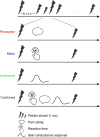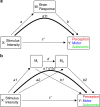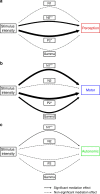Distinct patterns of brain activity mediate perceptual and motor and autonomic responses to noxious stimuli
- PMID: 30367033
- PMCID: PMC6203833
- DOI: 10.1038/s41467-018-06875-x
Distinct patterns of brain activity mediate perceptual and motor and autonomic responses to noxious stimuli
Abstract
Pain is a complex phenomenon involving perceptual, motor, and autonomic responses, but how the brain translates noxious stimuli into these different dimensions of pain is unclear. Here, we assessed perceptual, motor, and autonomic responses to brief noxious heat stimuli and recorded brain activity using electroencephalography (EEG) in humans. Multilevel mediation analysis reveals that each pain dimension is subserved by a distinct pattern of EEG responses and, conversely, that each EEG response differentially contributes to the different dimensions of pain. In particular, the translation of noxious stimuli into autonomic and motor responses involved the earliest N1 wave, whereas pain perception was mediated by later N2 and P2 waves. Gamma oscillations mediated motor responses rather than pain perception. These findings represent progress towards a mechanistic understanding of the brain processes translating noxious stimuli into pain and suggest that perceptual, motor, and autonomic dimensions of pain are partially independent rather than serial processes.
Conflict of interest statement
The authors declare no competing interests.
Figures







Similar articles
-
Perceptual and motor responses directly and indirectly mediate the effects of noxious stimuli on autonomic responses.Pain. 2019 Dec;160(12):2811-2818. doi: 10.1097/j.pain.0000000000001661. Pain. 2019. PMID: 31335751
-
Dissection of perceptual, motor and autonomic components of brain activity evoked by noxious stimulation.Pain. 2010 Jun;149(3):453-462. doi: 10.1016/j.pain.2010.01.005. Epub 2010 Apr 22. Pain. 2010. PMID: 20417032
-
Autonomic responses to tonic pain are more closely related to stimulus intensity than to pain intensity.Pain. 2017 Nov;158(11):2129-2136. doi: 10.1097/j.pain.0000000000001010. Pain. 2017. PMID: 28700538
-
Motor Responses to Noxious Stimuli Shape Pain Perception in Chronic Pain Patients.eNeuro. 2018 Nov 29;5(5):ENEURO.0290-18.2018. doi: 10.1523/ENEURO.0290-18.2018. eCollection 2018 Sep-Oct. eNeuro. 2018. PMID: 30713993 Free PMC article.
-
Divergent effects of conditioned pain modulation on subjective pain and nociceptive-related brain activity.Exp Brain Res. 2019 Jul;237(7):1735-1744. doi: 10.1007/s00221-019-05545-8. Epub 2019 Apr 27. Exp Brain Res. 2019. PMID: 31030281
Cited by
-
Intact painful sensation but enhanced non-painful sensation in individuals with autistic traits.Front Psychiatry. 2024 Jul 9;15:1432149. doi: 10.3389/fpsyt.2024.1432149. eCollection 2024. Front Psychiatry. 2024. PMID: 39045552 Free PMC article.
-
The analgesic effect and neural mechanism of spicy food intake.Soc Cogn Affect Neurosci. 2025 May 27;20(1):nsaf040. doi: 10.1093/scan/nsaf040. Soc Cogn Affect Neurosci. 2025. PMID: 40314109 Free PMC article.
-
Brain Responses to Surprising Stimulus Offsets: Phenomenology and Functional Significance.Cereb Cortex. 2022 May 14;32(10):2231-2244. doi: 10.1093/cercor/bhab352. Cereb Cortex. 2022. PMID: 34668519 Free PMC article.
-
Pain-Evoked Reorganization in Functional Brain Networks.Cereb Cortex. 2020 May 14;30(5):2804-2822. doi: 10.1093/cercor/bhz276. Cereb Cortex. 2020. PMID: 31813959 Free PMC article.
-
Neuroimaging-based evidence for sympathetic correlation between brain activity and peripheral vasomotion during pain anticipation.Sci Rep. 2024 Feb 9;14(1):3383. doi: 10.1038/s41598-024-53921-4. Sci Rep. 2024. PMID: 38337009 Free PMC article.
References
-
- Merskey, H. & Bogduk, N. Classification of Chronic Pain: Descriptions of Chronic Pain Syndromes and Definitions of Pain Terms (IASP Press, Seattle, 1994).
-
- Melzack, R. & Casey, K. L. in The Skin Senses (ed. Kenshalo, D. R. J.) 423–439 (Charles C. Thomas, Springfield, 1968).
Publication types
MeSH terms
Grants and funding
LinkOut - more resources
Full Text Sources
Medical

